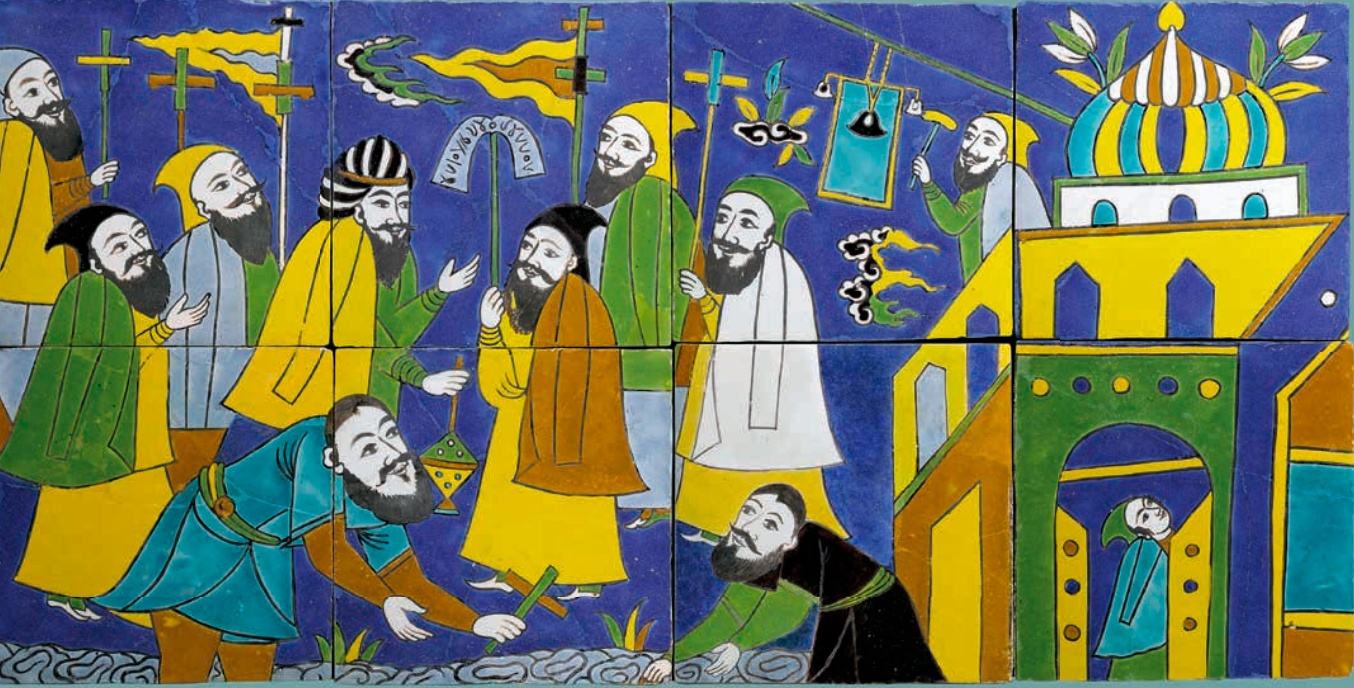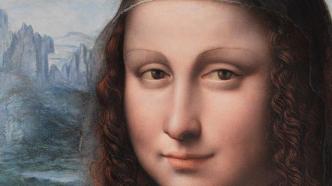
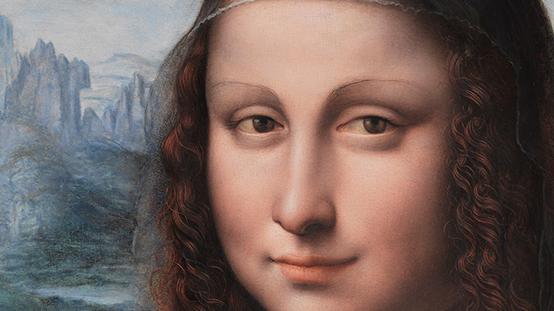
"Glorious Times: Spanish Past in the Prado Museum" will be opened at the Shanghai Pudong Art Museum this afternoon (April 22). As the largest exhibition held by the Prado Museum in Madrid, Spain in China, it presents 70 works by about 50 European artists in the Prado Museum's collection, 16 of which are leaving Spain for the first time and 9 are leaving the Prado Museum for the first time.
Among them, the biggest highlight, the "Mona Lisa" from Leonardo da Vinci's studio, attracted attention the day it was unboxed. In addition to the "Mona Lisa" in the Prado, what other highlights are there in this exhibition? What kind of Spanish history is told in this work spanning the 16th to 20th centuries?
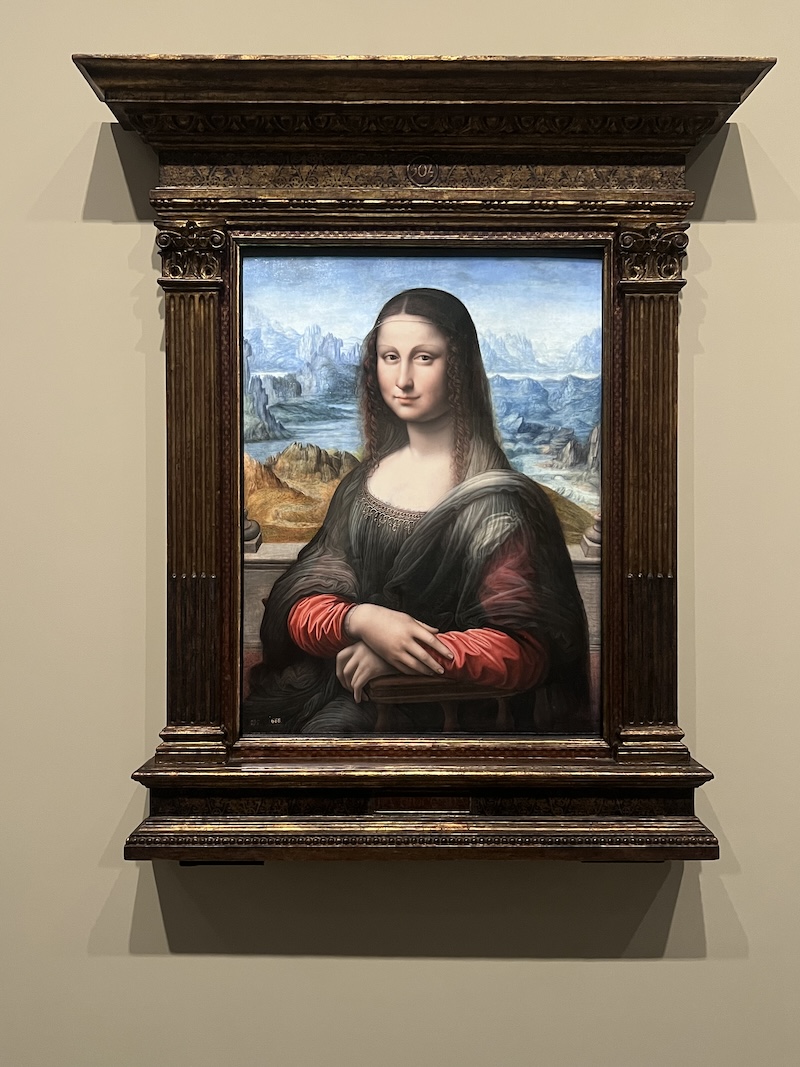
On April 16, a photo of the "Mona Lisa" from the Prado Museum after it was hung on the wall of the Pudong Art Museum.
Before the opening of the exhibition, The Paper interviewed the curator of the exhibition, Pedro J. Martínez Plaza from the 19th Century Painting Department of the Prado Museum. He believes that the connection between Western painting masters such as Titian, El Greco, Rubens, Velázquez, Murillo, Goya, Fortuny, Sorolla and others is a clue to painting influenced by the Renaissance; at the same time, the famous Habsburg dynasty in European history and Spanish culture and society are another clue to the exhibition.

Pedro J. Martínez Plaza, 19th Century Paintings Department, Prado Museum
Mutual influence of European art
The Paper: The exhibition is called "Glorious Times: Spanish Past in the Prado Museum". What is the focus of the "Spanish Past"? What are the "Spanish Past" in the Prado Museum?
Prasa: The Prado Museum has an unshakable position in Spain and is one of the best museums in the country. The Prado Museum has a close connection with the Spanish Royal Collection and has also received donations from all walks of life. It can be said that the Prado Museum's collection is the most suitable institution to present "Spain's past" to the public.
In terms of genre and time logic, the exhibition goes from the Habsburg dynasty to the Bourbon dynasty, and then to the bourgeoisie and the new aristocracy depicted in 19th-century portraits. We hope to bring the works of some of the most important and representative painters of the Prado to China through the exhibition; we also hope that the exhibition will present the history of Spain, the culture and social conditions of the territories under Spanish rule; and understand the history of Spain and art history from an artistic perspective.
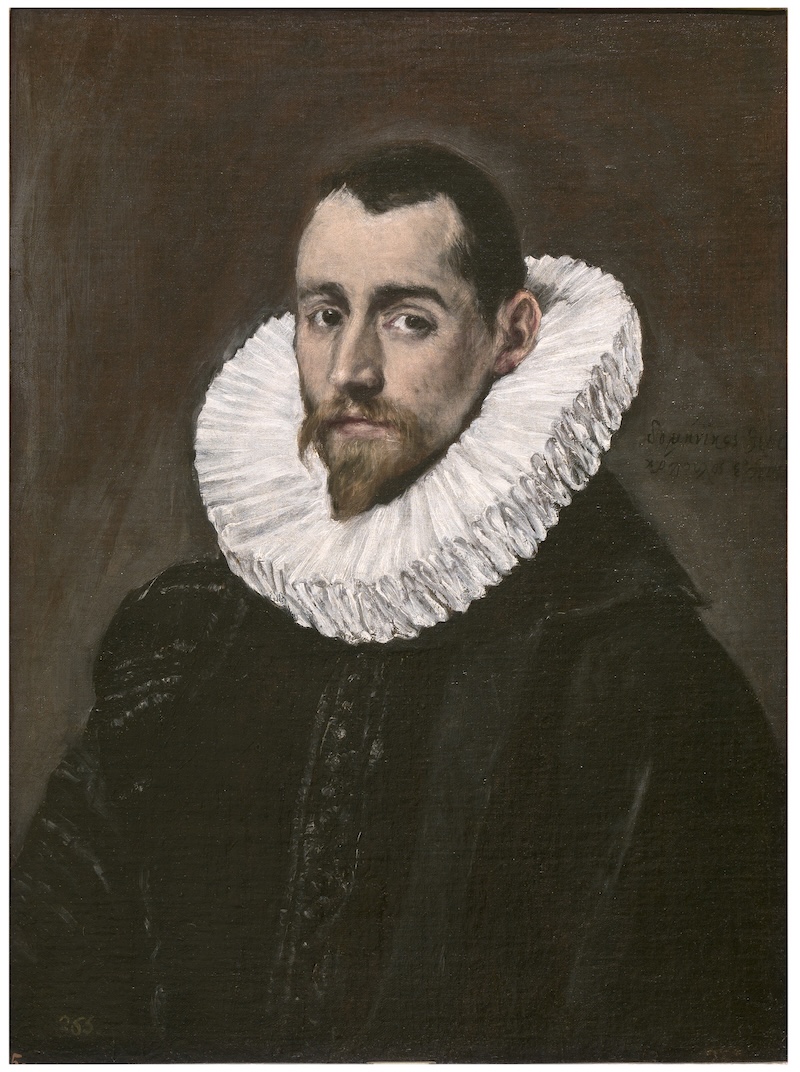
El Greco, Portrait of a Young Gentleman, circa 1600-1605, oil on canvas, collection of the Prado National Museum
Specifically, the exhibition first focuses on the royal portraits of the Habsburg dynasty and court life (including actor paintings); next is the customs and daily life of Spain and the territories under Spanish rule; and religious life, which is very important to Spain, and then slowly from the 16th to the 19th century, not only paintings, but also timelines, royal family trees, etc. to present the "Spanish Past".

At the exhibition, Rubens' "Philip II on Horseback" (right) and actor paintings.
The Paper: The exhibition involves the art of the Spanish Renaissance. How did the Italian Renaissance spread to Spain? How did it merge with the local Catalan and Valencian schools? How is it reflected in the works on display in this exhibition?
Plaza: The fusion of Spanish and Italian Renaissance is best reflected in the exhibition hall presenting religious paintings. Two works by Juanes on display were influenced by Raphael. Juanes was a Valencian painter, and his works were also obviously influenced by the Naples region of Italy. Italian Renaissance paintings were first introduced to Spain, and also first arrived in Valencia. Then there was El Greco, who went to Venice to study, and the style of the Venetian school of painting was reflected in his paintings.
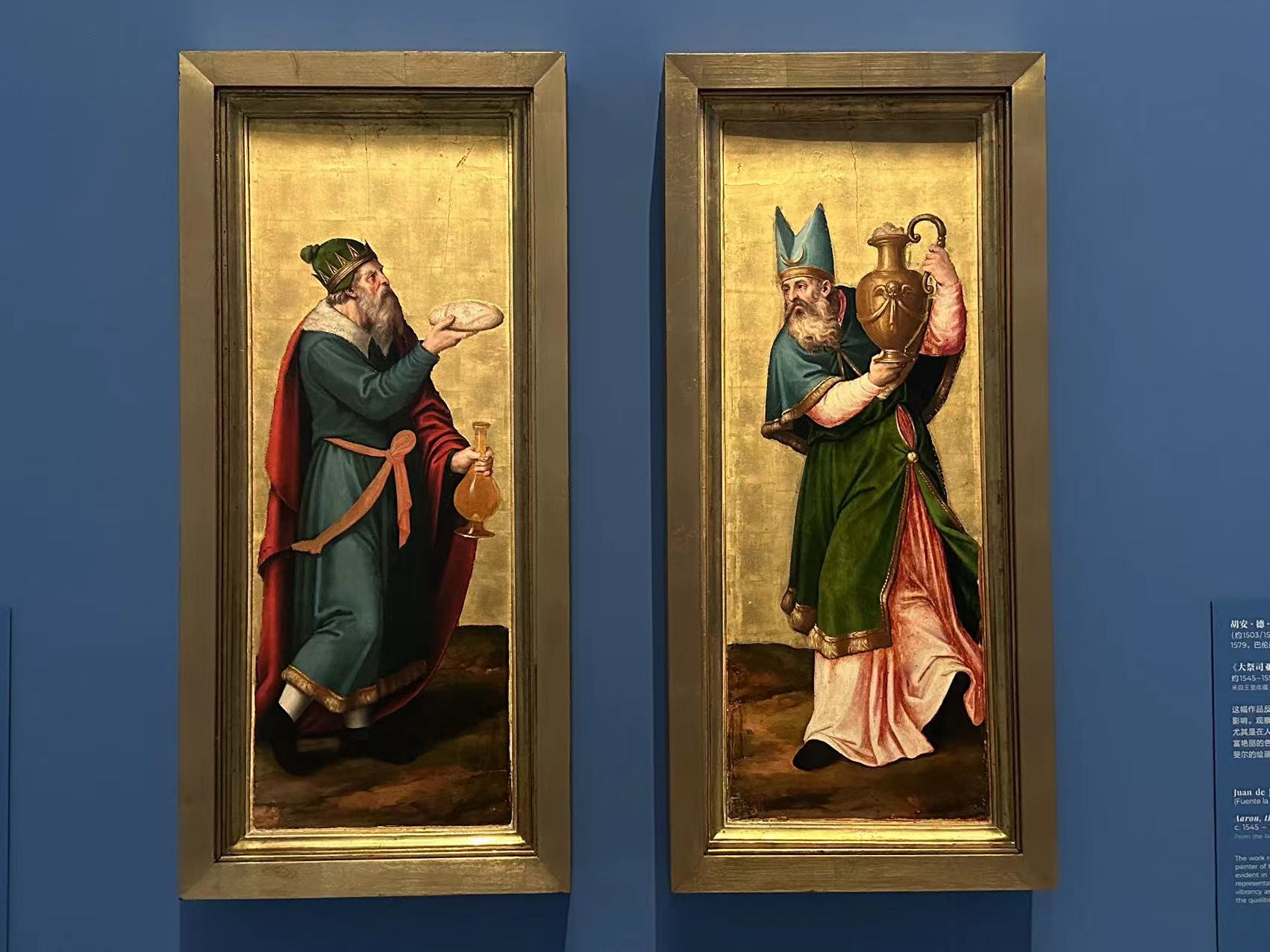
The exhibition site, two works by Hua Ness
Among them, the work "The Temptation of St. Anthony" by Bosch's followers is particularly worth mentioning. Due to objective conditions, it is not convenient for Bosch's works to be exhibited in museums, so it is very rare for one of them to come to China.
Bosch was one of the most famous painters of the Flemish school and was highly appreciated by Philip II. He gained fame during his lifetime due to his unique painting style, superb technique and the universality of his themes, which revealed the weaknesses of human nature and were thought-provoking. After his death, many followers continued to reproduce his works, especially in Italy and Spain, and this imitation continued until the end of the 16th century.

A Follower of Bosch, The Temptation of Saint Anthony, 1550-1560, oil on wood, donated by Alice Piet van Buuren in 1965, collection of the Museo Nacional del Prado
The juxtaposition of the works of Vannes and Bosch (whose followers) shows the Renaissance in the south and north of Europe, respectively. In particular, the difference between the works of the Flemish Renaissance, which in some ways seem a little backward, reminiscent of the Middle Ages, and the Italian-influenced Spanish Renaissance paintings, which are clearly more modern.
Although one of the star exhibits in this exhibition is the Mona Lisa from Leonardo da Vinci's studio, when this work entered the royal collection in the 17th century, Spanish portraiture had already developed and matured. As far as this work alone is concerned, the impact on Spanish art is limited. But there are indeed Spanish painters who have studied in Leonardo da Vinci's studio, such as Fernando Yáñez de la Almedina and Fernando Llano, who are Valencian painters and can be said to be followers of Leonardo da Vinci. At that time, many Italian painters came to Valencia, and they mainly painted murals and decorative works in churches. Seville, a city in southern Spain, is also a place that has been greatly influenced by Italian art. Not only paintings, but also Italian sculptures have had an impact on Spain. Some sculptures were even completed in Italy, shipped to Spain in batches, and then reassembled. This cultural exchange brought the Italian Renaissance to Spain.
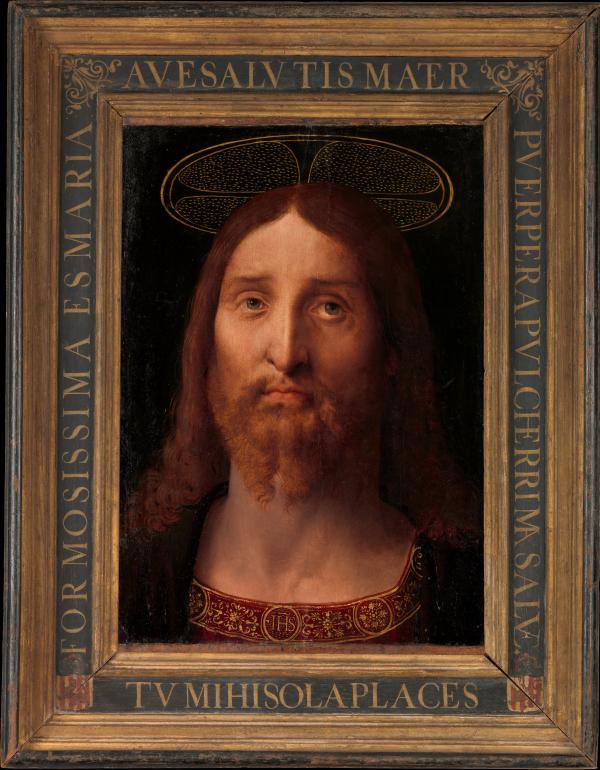
Fernando Yáñez de la Almedina (Spanish painter, influenced by Leonardo da Vinci), Head of Christ, circa 1506, in the collection of the Metropolitan Museum of Art, New York (not on display)
But the Spanish art that was clearly influenced by Leonardo da Vinci may be more reflected in the works depicting the Virgin Mary. This is why the Mona Lisa is listed separately on the first floor as a special exhibition to tell its own story.
The Paper: In the exhibition, the stories of several artists are particularly noteworthy. For example, Titian was already famous during the Renaissance and had a direct influence on the Baroque. El Greco received Titian's guidance in Venice and became his disciple. In 1628, Rubens, an important Baroque painter, was sent to Madrid by the British royal family as an ambassador to paint a portrait of the princess who was about to marry into the UK. He was amazed when he saw Titian's paintings in the Prado and copied Titian's masterpieces "The Rape of Europa" and "The Feast of Andros". Rubens then wrote a letter to a boy in Seville, asking him to come to Madrid to see Titian's paintings. This guy was called Velázquez and later became the royal painter of the Spanish royal family. What is the inheritance relationship between Titian, El Greco, Rubens, and Velázquez?
Plaza: There are two main paths. One of the paths that Italy influenced Spanish painting is Titian. From the period of Charles V (1500-1558) to Philip II (1527-1598), Titian's (1488/1490-1576) works entered the collection of the Habsburg royal family and became the core of their collection. Later painters continued to learn from Titian. One of them was Rubens (1577-1640). After Rubens came to the Spanish court to study Titian's paintings, his style was completely different. The second path is El Greco (1541-1614). El Greco studied painting in Italy and brought the Venetian School of Painting to Spain. The characteristic of the Venetian School of Painting is that it pays more attention to color than lines.

Exhibition site, Titian's work "Venus Intoxicated with Love and Music"
Although the shadow of Titian can be seen in the works of Rubens and Velázquez (1599-1660), they learned different aspects of Titian. What we see in the nude painting exhibition area is Rubens' inheritance of Titian's female body beauty, and this learning focuses more on perception and color; Velázquez may be the inheritance of Titian in terms of techniques and brushstrokes.

Exhibition view, Peter Paul Rubens and his studio, "Diana the Huntress"
Then, Goya (1746-1828) came to the Spanish Royal Palace from Zaragoza. As the royal painter, he learned from Titian and Velázquez in the royal collection and passed down the art. For example, Sorolla and Madrazo in the exhibition learned the style of Goya, and of course inherited Titian, Rubens and Velázquez. This is also the clue and logic of the inheritance of Spanish painting. Of course, Titian and Rubens cannot be regarded as Spanish painters.
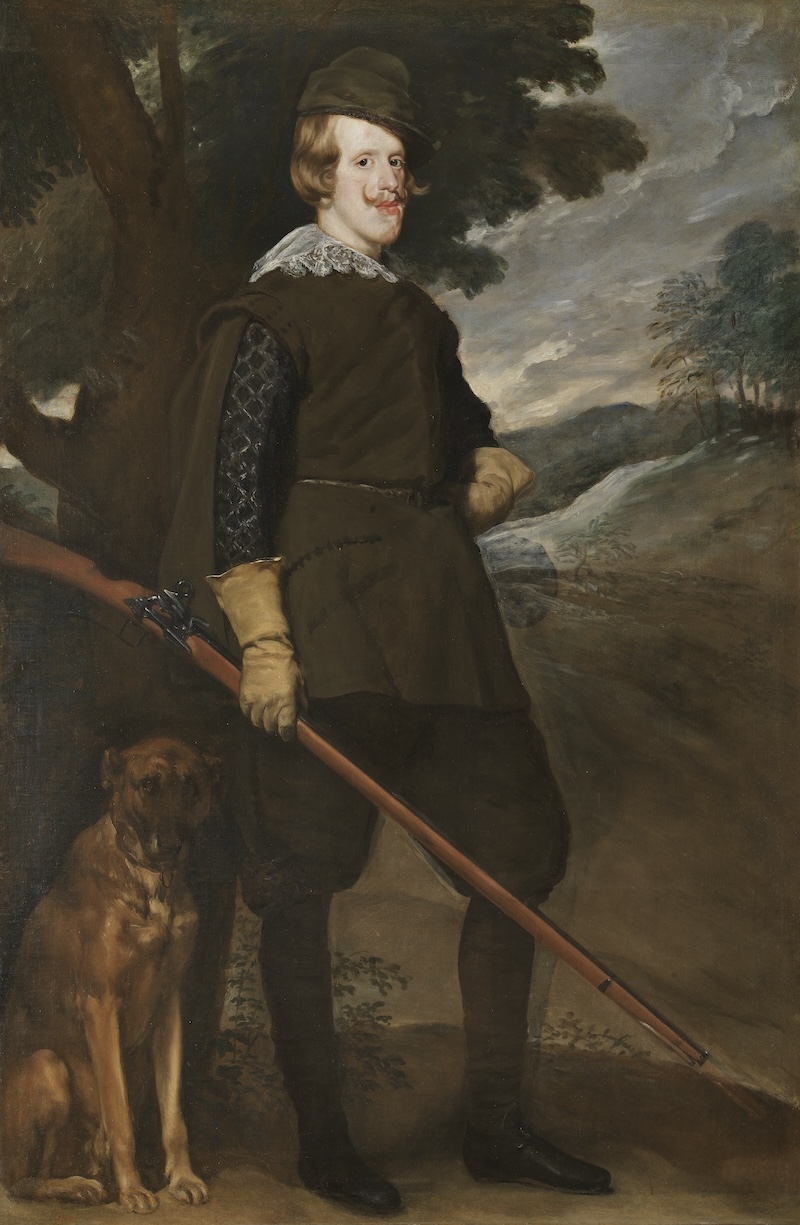
Diego Velázquez, "Felipe IV in Hunting Costume", circa 1632-1634, oil on canvas, Museo Nacional del Prado
The Paper: The exhibition also involves Bruegel and the Flemish School. The art phenomenon in Flemish in the 17th century was also complex, reflecting not only the aesthetic tastes of the country's court nobles, church, and merchants, but also the influence of foreign art. What is the relationship between the Flemish School and Spanish art?
Plaza: Since the 15th century, Spain and Flanders have started commercial exchanges and political connections. The connection between the Flemish School and Spanish painting also has many paths - original paintings, painters (such as Rubens), prints (Belgium and the Netherlands are popular with etchings), tapestries, etc. In the 15th century, Spanish painting probably learned some from Italy and some from Flanders.
Including Murillo's monumental work "St. Augustine between Christ and the Virgin" in the exhibition, which bears traces of the Flemish school of painting and is also a pinnacle of religious painting in the Spanish Baroque period.
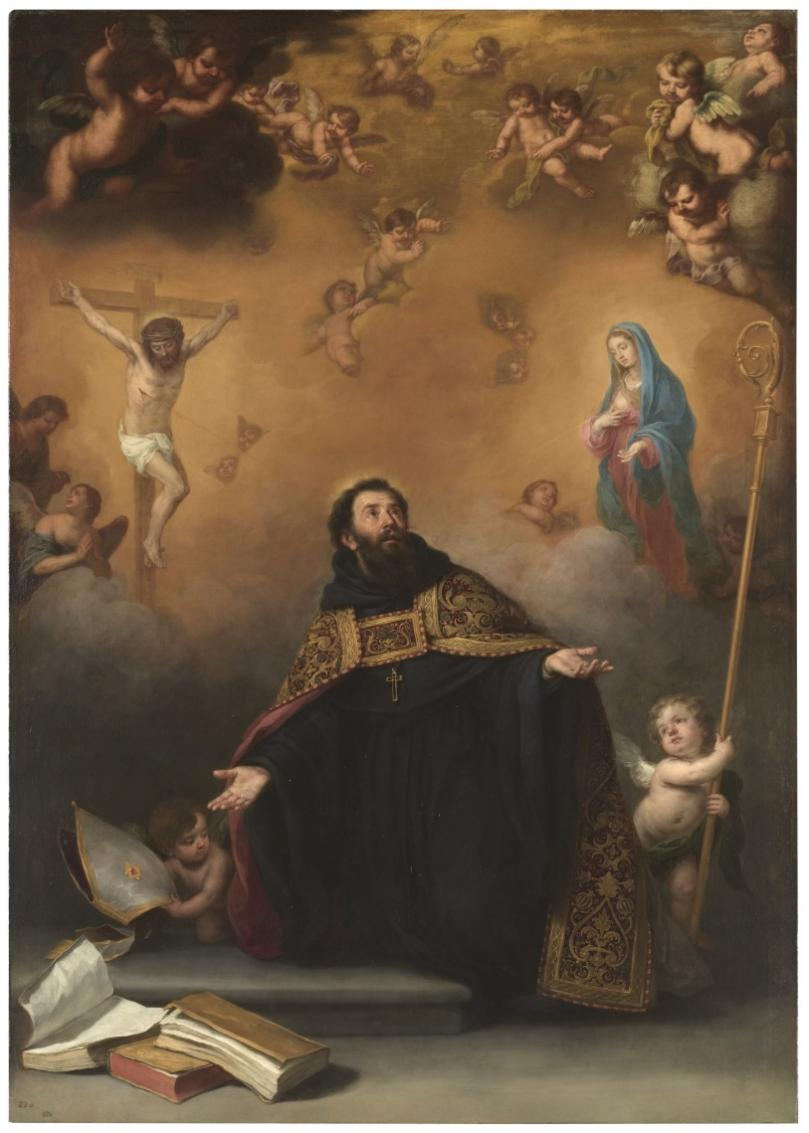
Murillo, Saint Augustine between Christ and the Virgin, circa 1665, oil on canvas, from the Royal Collection, Museo Nacional del Prado
Including the famous Flemish painter Juan De Flandes (1460-1519), who was active in Spain after 1496 until his death, working mostly for Queen Isabella I of Spain.
In the 16th and 17th centuries, very important Flemish painters came to the Spanish court. They may have had diplomatic purposes at first, but were later commissioned by the Spanish royal family to paint many works. Flemish prints came to Spain and had an impact on the art field, especially the Madrid School and the Seville School, which were obviously influenced by the Flemish region. In the exhibition, Juan van der Harmen-Leon and Clara Petters were exhibited together, and their paintings both have Flemish traditions. In the 17th century, Flanders was a land under Spanish rule, and exchanges were more convenient, and the influence could be said to be mutual.

Juan van der Harmen-Leon, Still Life with Desserts and Glass Vessels, 1622, Oil on canvas, From the Royal Collection, Museo Nacional del Prado
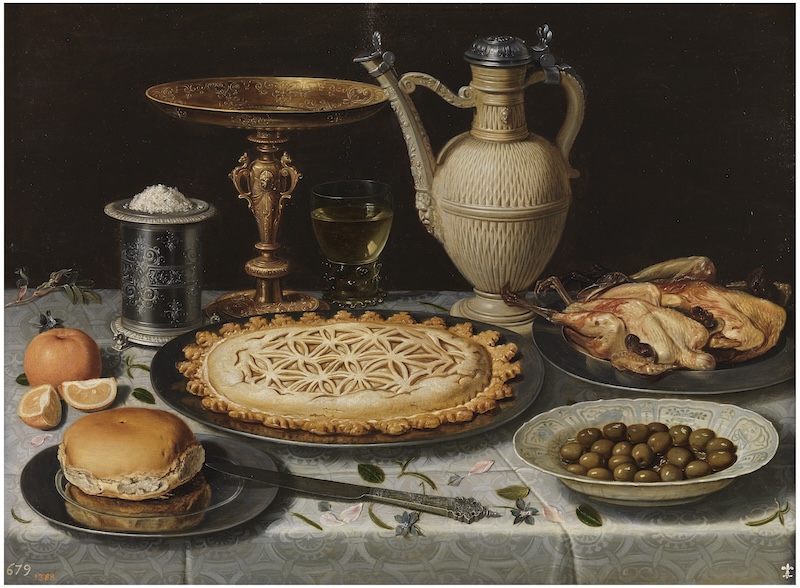
Clara Petters, Still Life: Table with Tablecloth, Salt Cellar, Gold Cup, Cakes, Jug, Olives on a Porcelain Plate, and Roast Poultry
Circa 1611, oil on wood panel, Museo Nacional del Prado
The Spanish Royal Family, the Art Market, and the Modern Era
The Paper: Many works in this exhibition come from the Spanish royal family. What role did the royal family play in the development of Spanish art and culture? At the same time, we cannot ignore the private collections and art market in Madrid. What did private collections look like at that time?
Prasa: The Spanish royal family has a great relationship with the Prado Museum, as well as Spanish art and culture. The Prado Museum received most of the Spanish royal family's art collections. The Spanish royal family is also the most important "art patron". For example, Charles V and Felipe II purchased a large number of Titian's works. Felipe IV was the art patron of Velázquez, and Carlos IV was the art patron of Goya. The "patron" mentioned here is different from the "art patron". In addition to Titian, Velázquez and Goya were court painters who directly served the royal family. There was even a period of time when they had special permissions - only Velázquez could paint Felipe IV, and only Goya could paint Carlos IV.
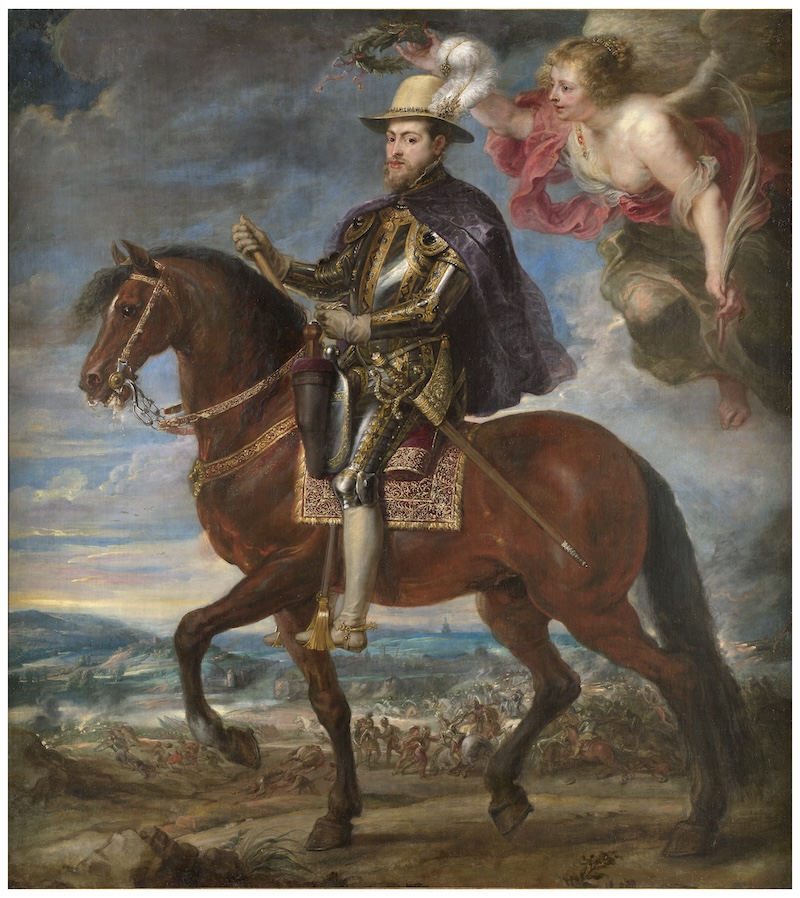
Peter Paul Rubens, "Philip II on Horseback", circa 1630-1640, oil on canvas, Museo Nacional del Prado
Goya can be said to be the last royal painter. In the 19th century, the portraits painted by the painter were no longer just portraits of royal family members, but also portraits of the bourgeoisie and the new aristocracy. It can be said that the bourgeoisie and the new aristocracy replaced the royal family as the main customers of the painter. In the exhibition, there is a portrait of a lady whose husband is a collector.
At the same time, portraits have also broken through the original form, such as "Bullring Stable Courtyard before the Bullfight". The perspective of looking at the new world, or a kind of thinking, is not only reflected in portraits, but also in landscapes.

Joaquín Sorolla, "The Foolish Girl Played by the Actress María Guerrero", 1906, oil on canvas, Museo Nacional del Prado
The Paper: What are the differences between painters painting portraits of the royal family, religious subjects, and portraits of themselves (or their families) and the secular public or private collections? What kind of traditions are involved?
Plaza: Of course there are differences, for example, compare Velázquez's portrait of the actor and Felipe IV. When painting portraits of the royal family, there are many symbols, such as the crown, power, victory, and even hunting is a symbol. There is also the royal family's demand for a sense of space in the painting, all of which naturally disappears in the actor's painting.

Velázquez, The Comic Carabasías, circa 1638, oil on canvas, Museo Nacional del Prado
Therefore, in the first exhibition hall, the royal portraits of the Habsburg dynasty show the symbol of power. For example, the pillar behind the work "Elizabeth de Valois Holding a Portrait of Philip II" is a symbol of her husband and the royal family; "Philip IV in Hunting Clothes" shows the scene of the hunting ground, which requires hunters to have courage and boldness, which is related to the battlefield; including the medals they wear, are the embodiment of military merit, all of which are symbols of power.

Sofonisba Anguissola, Elizabeth of Valois holding a portrait of Philip II, 1561-1565, oil on canvas, from the Royal Collection, Museo Nacional del Prado
The portrait scenes of the bourgeoisie are completely different, very everyday scenes. For example, a lady was portrayed in the studio.

Vicente Palmaroli-González, In the Studio, circa 1880, oil on canvas, Museo Nacional del Prado
The Paper: One of the highlights of this exhibition is Goya's eight masterpieces. How were these eight works selected? What aspects of Goya do they represent?
Plaza: The eight works by Goya are divided into two parts. One is two portraits of the royal family. Another exhibition area is designed entirely for Goya. Six of the works hope to show Goya's paintings of different types and genres, and also hope to show Goya's paintings from different periods of his painting career.
In this exhibition area, there is an early work of Goya, "Tobias and the Angel", which contains some elements and styles of his paintings, and has become the object of study for later painters. For example, the use of light in the painting. People stand out from the dark background with strong light, which is very typical of Goya, and this feature can also be seen in the paintings of his apprentices and followers.
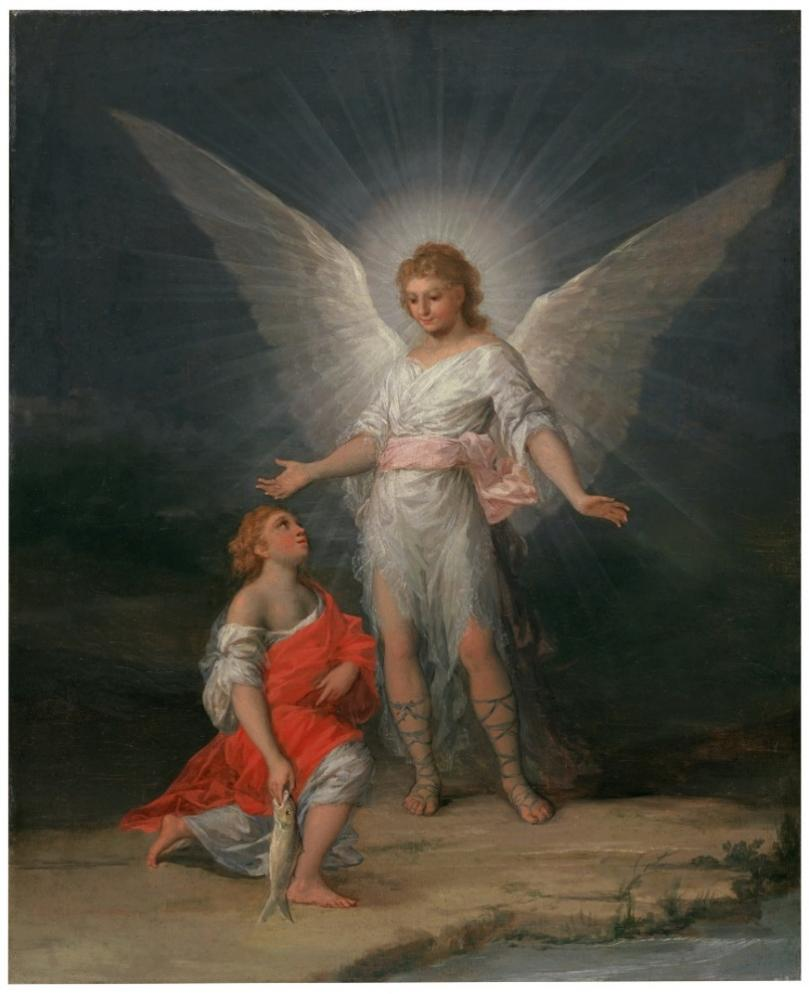
Goya, Tobias and the Angel, circa 1787, oil on canvas, purchased in 2003, collection of the Museo Nacional del Prado
Next are several tapestry landscapes by Goya. Goya once worked at the Royal Tapestry Factory, and these are the samples he designed for tapestries, but apart from that, we can see how Goya used a modern vision and brushstrokes to describe the scenery he saw.
In an early, small-scale drawing made for a tapestry, Goya's early observation and depiction of reality or the surrounding environment can be seen, including some details such as the church and the lady's veil. Although it is just a pattern, Goya was able to describe the details very clearly in a very short time, or in just a few strokes.
"The Parasol" and "Boy Picking Fruit" are both tapestry samples. Here, they are not only depictions of people and scenery, but also have an educational function. This is one of the characteristics that distinguishes Goya from other painters.
The Parasol is not just what we see. The guy who wants to hold the parasol for the lady is actually trying to flirt with her, but the lady ignores him. Its educational significance is to hope that everyone stays away from such bad morals. There is also a dog in the painting, which often carries negative connotations in the West.
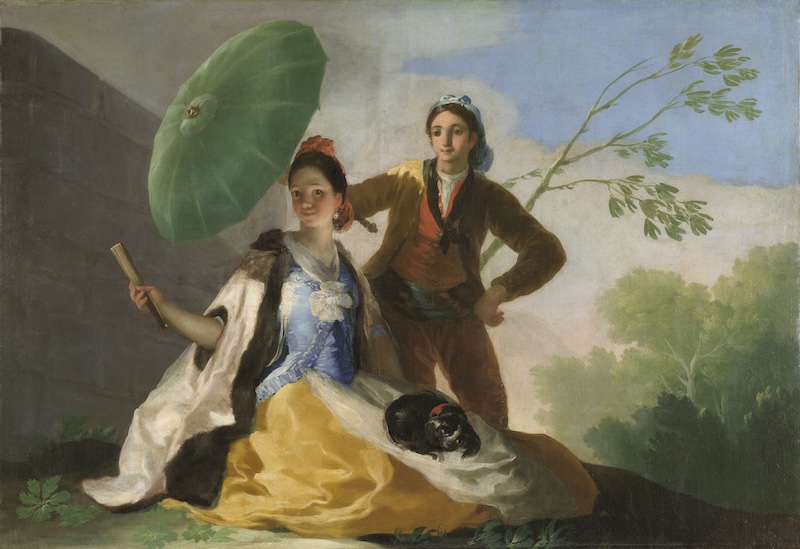
Francisco de Goya, The Parasol, 1777, oil on canvas, Museo Nacional del Prado
Why is Goya considered a modern painter? In "Painter Francisco Bayeu", we can feel that he depicted his brother-in-law (his wife's brother), especially from his eyes, we can see the character of the person Goya wanted to depict. He may have some violence or an angry expression. This is the embodiment of Goya's modernity - the grasp of character and human nature.
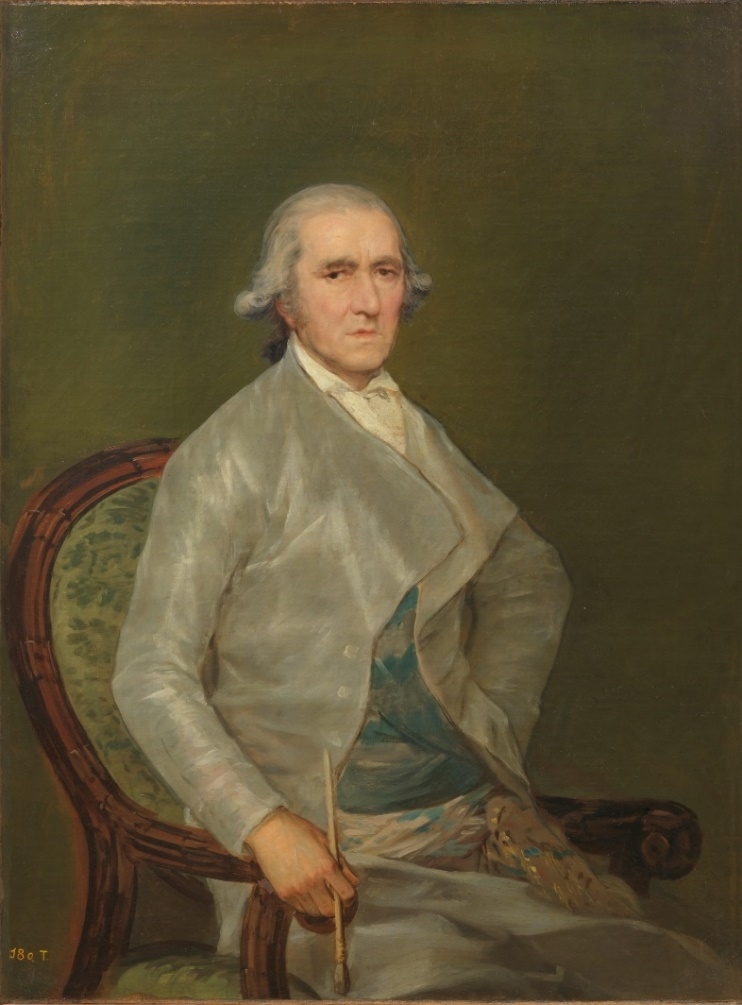
Goya, The Painter Francisco Bayeu, 1795, oil on canvas, Museo Nacional del Prado
Goya has many followers, and he has influenced many people, but Eugenio Lucas may be the best example. Such influence is not only in the Maja in the painting content, but also in the clothing of women in the Madrid area, as well as the use of light and shadow. Goya is also multifaceted, with different periods, different faces and styles. Lucas's "Maja" is related to Goya's more friendly and kind side. "The Inquisition" may remind people of Goya in the dark period. In the use of light and shadow, it can also be clearly seen how to use prominent light to make the characters stand out from the dark background.

Lucas, "Maha", circa 1855-1860, oil on canvas, collection of the Prado National Museum
The Paper: Goya's works symbolize the beginning of modern art. How did he influence later artists? In the 20th century modern art period, artists such as Picasso, Dali, and Miró all came from Spain. What influence did the collections of the Prado Museum have on their art?
Plaza: Goya’s brushstrokes are more casual, more energetic, and modern. For example, the sleeves of the Bayeux are more obvious, including the eyes of the characters just mentioned. A more general influence is Manet, who came to Spain in 1865, saw Goya’s works, and learned from him. In the 1860s, the French began to collect Goya’s works.
As for the surrealists Dali and Miro, Miro is more original, and it is almost impossible to clearly see the shadow of traditional European painting. But Dali may be closely connected with the European, or Spanish, tradition due to the era he lived in, and he also learned Spanish traditional art well. Therefore, Dali's "Dead Bird" currently on display on the 4th floor of Pudong Art Museum is influenced by traditional European still life paintings. Dali left many traces in the Prado Museum, and he also copied paintings in the Prado, and these scenes were also recorded in photos.

Dali's "Dead Bird", from the exhibit "A Century of Rhapsody: Surrealist Masterpieces from the National Galleries of Scotland" at the Pudong Art Museum.
Dali also linked surrealism with the famous work "Las Meninas" in the Prado, showing the combination of modernity and Spanish tradition. Picasso even made 58 works related to "Las Meninas", and some of the portraits Picasso made for his friends would also add elements of El Greco.
Note: The exhibition is produced by Shanghai Lujiazui (Group) Co., Ltd. and co-organized by the Prado National Museum and Pudong Art Museum. The exhibition will last until September 1.
